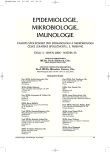Head Louse: Taxonomy, Incidence, Resistance, Delousing
Authors:
V. Rupeš 1; J. Vlčková 2; L. Mazánek 3; J. Chmela 3; J. Ledvinka 4
Authors‘ workplace:
Státní zdravotní ústav Praha
1; Zdravotní ústav, Olomouc
2; KHS Olomouc
3; KHS Plzeň
4
Published in:
Epidemiol. Mikrobiol. Imunol. 55, 2006, č. 3, s. 112-119
Overview
Based on the current knowledge, head louse (Pediculus capitis) and body louse (Pediculus humanus) are two different species that infest specific parts of the human body and do not interbreed in vivo. In 1991–2002, 6 257 cases of pediculosis were reported in the Czech Republic while 3 138 000 pediculicide packagings, i.e. about 500 times as many as the number of cases, were marketed. Between October 2004 and February 2005, a total of 531 children aged between 6 and 15 years from 16 selected schools in the Zlín and Olomouc regions were screened by dry hair combing. Living lice were detected in 14.1 % of the enrolled children and dead nits alone were observed in other 9.8 % of the subjects. In vitro tests revealed that the collected head lice were highly resistant to malathion, the active ingredient of Diffusil H 92 M. The number of reported cases of pediculosis roughly doubled in 2005.
Key words:
head lice – Pediculus capitis – infestation – control – resistance to insecticides.
Labels
Hygiene and epidemiology Medical virology Clinical microbiologyArticle was published in
Epidemiology, Microbiology, Immunology

2006 Issue 3
Most read in this issue
- Aeromonas spp. as the Causative Agent of Acute Diarrhoea in Children under 1 Year of Age
- Head Louse: Taxonomy, Incidence, Resistance, Delousing
- Seroprevalence of Antibodies Against Hepatitis A Virus and Hepatitis B Virus in Nonvaccinated Adult Population over 40 Years of Age
- Molecular Detection and Subtyping of Treponema pallidum subsp. pallidum in Clinical Specimens
